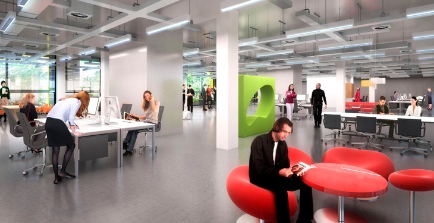Published Tuesday, February 5th, 2013, by Mike Sullivan.

The workplace as we know it is undergoing a major sociological shift, one fueled by our reliance on technology, employees? desire for greater control over their time, and companies? need to reduce overhead costs. So says Dianne A. Dunnell, a senior associate and project interior designer at Marguilies Perruzi Architects in Boston.
?This shift is changing how people work and spend their days, and even affects our social relationships in a work setting,? Dunnell says. ?Many companies are moving toward an alternative workplace design, a design philosophy that is championed by executive leadership, human resources, and facility managers, and lauded by thousands of employees as the new way we want to work.?
Defining Alternative Workplace Strategy
As Dunnell defines it, alternative workplace design encompasses work practices, settings and locations. The alternative workplace model is also known as high performance workspace, workplace transformation or workplace innovation, as it substantially deviates from traditional office designs and practices. Dunnell describes alternative workplace spaces as characterized by:
? Open space
? Flexible seating arrangements
? Areas for collaboration and communication
? Areas for quiet work
? Embracing technology to tie the office and its employees together
?Most companies take the concept further and support work-from-home options that increase employees? flexibility as well as their productivity. When the employee is in the office, he or she is there for collaboration and communication with others, not deskwork that can otherwise be done at home,? Dunnell says.
?Other companies reduce their real estate burden by employing a sit-where-you-want desk arrangement. With this style of workplace innovation, employees are encouraged to work ?their way,? limiting their commute time and managing their own schedules and personal lives.?
Reducing Space Requirements
As Dunnell sees it, there?s a legitimate real estate argument for facility managers to consider alternative workplace design: the alternative workplace model reduces the amount of space that is unoccupied on any given day, thus reducing the overall square footage per person by eliminating unused real estate.
?The design offers a better use of space by taking into consideration employee travel, sick time, and vacation schedules and work arrangements that have employees out of the office one or two days a week,? she says. ?Why pay for real estate when 30 to 50 percent of an employee?s time is spent in places other than the office??
AWS And Your Business Center
How does this impact your business center? Although we?ll dive deeper into the issue of alternative workplace strategies in other articles in this series, we can already glean some insights for business centers.
First, business center management must acknowledge that the workplace has, in fact, changed to fit the changing lifestyles and generational attitudes of the workforce. That spells opportunity for business centers, especially those who focus on virtual offices, meeting rooms and target mobile workers. If business centers position themselves correctly, they will attract a new breed of workers and drive new revenue through the door. If business centers don?t recognize and embrace the shift, they will leave money on the table.
Second, business centers should consider alternative workplace design. In doing so, it?s possible to generate more income in less square footage. That doesn?t mean that you do away with traditional executive office suites, but it means testing market demand for open space, flexible seating arrangements, areas for collaboration and communication and new technologies.
The demands of modern workers is changing ? and that?s changing traditional office space. Alternative workspace providers shouldn?t rest on their laurels and think that flexible leasing terms alone are enough to get the attention of companies and entrepreneurs. It?s time to reconsider your marketing strategies, and it may be time to reconsider your office design too.
In part two of this series, we?ll look at what it takes to be successful with alternative workplace strategies.
Image: Amsterdam?s Alphabet Building is a great example of alternative office design.
ABOUT THE AUTHOR
Mike Sullivan
Mike Sullivan is an entrepreneur and marketing professional who tries to keep things humming along as best as possible. From time to time, he updates Officing Today, but mostly he can be found on Skype talking with someone about virtual offices. Connect with Mike Sullivan on LinkedIn.
Source: http://www.officingtoday.com/2013/02/new-alternative-workplace-strategies-part-i-changes-to-expect/
cheryl burke sarah burke mega upload santorum wins iowa archer ibooks 2 ifl
No comments:
Post a Comment